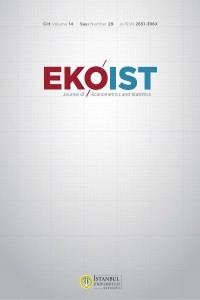Exchange Rate Volatility in the Covid-19 Period: An Analysis Using the Markov-Switching ARCH Model
Most analyses of exchange rate volatility in the economic literature are conducted by means of autoregressive conditional heteroskedasticity (ARCH) or generalized ARCH (GARCH) models. According to Humilton and Susmel such models often predict higher volatility than their actual volatility rates, and their predictive performance is considerably low. Diebold and Lamoureux and Lastapes attributed this to the structural change in the ARCH process. Moreover, Hamilton and Susmel developed the Markov-switching ARCH (MS-ARCH or SWARCH) model to overcome the reliability problem of parameter estimates that do not allow for a regime change. This method presents a nonlinear structure enabling regime changes. Therefore, the MS-ARCH method was preferred in the study. Considering the continuing massive impact of COVID-19 on the global financial system, its influence on exchange rates must also be explored. This question was addressed in the analysis. In this direction, the effect of volatility was estimated with the MS-ARCH model using the return values of USD/TRY exchange rate in the trading days between March 2020 and October 2021, the month March 2020 when the first COVID-19 case appeared in Turkey. Two volatility regimes, namely, low volatility and high volatility, were employed in the study. The findings demonstrate that the COVID-19 pandemic, along with various economic and political events in Turkey and the world, affects exchange rate volatility and that these volatility periods are permanent. It also depicts that the USD/TRY return series has high volatility and a strong regime dependency. From these results, it may be concluded that the forecasting of information on exchange rate volatility is important for asset pricing and risk management because exchange rate volatility can increase transaction costs and reduce gains in international trade. The article contributes to the existing body of literature by explaining volatility modeling in the light of the recent daily exchange rate returns during the COVID-19 pandemic.
Keywords:
COVID-19, Monetary Policy, Exchange Rate, Volatility MS-ARCH,
___
- Abdalla, S. Z. S. (2012). Modelling exchange rate volatility using GARCH models: Empirical evidence from Arab countries. International Journal of Economics and Finance, 4(3), 216-229.
- Ayhan, F., & Abdullazade, M. (2021). Türkiye Ekonomisinde Covid-19 Salgını sonrasında Petrol ve Altın Fiyatları ile Vaka Sayılarının Döviz Kuru Üzerindeki Etkileri. Yaşar Üniversitesi E-Dergisi, 16(62), 509-523.
- Benzid, L., & Chebbi, K. (2020). The impact of COVID-19 on exchange rate volatility: evidence through GARCH model. Available at SSRN 3612141.
- Bollerslev, T. (1986), Generalized Autoregressive Conditional Heteroskedasticity, ARCH Selected Readings Advanced Texts in Econometrics, pp.44, 48.
- Contuk, F. Y. (2021). Covid-19'un Borsa İstanbul Üzerindeki Etkisi: Bir ARDL Sınır Testi Modeli. Muhasebe ve Finansman Dergisi, (89), 101-112.
- Dieobold, F. X. (1986). Modeling the persistence of conditional variances: A comment. Econometric Reviews, 5(1), 51-56.
- Epaphra, M. (2016). Modeling exchange rate volatility: Application of the GARCH and EGARCH models. Journal of Mathematical Finance, 7(1), 121-143.
- Goutte, S., & Zou, B. (2013). Continuous time regime-switching model applied to foreign exchange rate. Math. Finance Lett., 2013, Article-ID.
- Güloğlu, B., & Akman, A. (2007). Türkiye’de döviz kuru oynaklığının SWARCH Yöntemi ile analizi. Finans Politik & Ekonomik Yorumlar, 44(512), 43-51.
- Güloğlu, B. (2008). Exports and volatility of exchange rate under alternative exchange rate regimes: The case of Turkey. In Proc. The International Conference on Policy Modeling, EcoMod, Berlin.
- Hamilton, J. D., & Susmel, R. (1994). Autoregressive conditional heteroskedasticity and changes in regime. Journal of econometrics, 64(1-2), 307-333.
- Iqbal, N., Fareed, Z., Shahzad, F., He, X., Shahzad, U., & Lina, M. (2020). The nexus between COVID-19, temperature and exchange rate in Wuhan city: new findings from partial and multiple wavelet coherence. Science of The Total Environment, 729, 138916.
- İşler, İ. İ., & Güven, A. (2021). Covid 19 Küresel Salgınının BIST 100 Endeksi Üzerindeki Etkileri. Politik Ekonomik Kuram, 5(1), 63-77.
- Kayral, İ. E., & Tandoğan, N. Ş. (2020). BİST100, Döviz Kurları ve Altının Getiri ve Volatilitesinde COVID-19 Etkisi. Gaziantep University Journal of Social Sciences, 19, 687-701.
- Kearney, C., & Patton, A. J. (2000). Multivariate GARCH modeling of exchange rate volatility transmission in the European monetary system. Financial Review, 35(1), 29-48.
- Lamoureux, C. G., & Lastrapes, W. D. (1990). Persistence in variance, structural change, and the GARCH model. Journal of Business & Economic Statistics, 8(2), 225-234.
- Nafisah, N., & Pratiwi, H. (2020). Early detection of Indonesian financial crisis using combination of volatility and Markov switching models based on indicators of real exchange rate and M2/foreign exchange reserves. In Journal of Physics: Conference Series (Vol. 1563, No. 1, p. 012001). IOP Publishing.
- Narayan, P. K. (2020). Has COVID-19 changed exchange rate resistance to shocks?. Asian Economics Letters, 1(1), 17389.
- Panopoulou, E., & Pantelidis, T. (2015). Regime-switching models for exchange rates. The European Journal of Finance, 21(12), 1023-1069.
- Pilbeam, K., & Langeland, K. N. (2015). Forecasting exchange rate volatility: GARCH models versus implied volatility forecasts. International Economics and Economic Policy, 12(1), 127-142.
- Qasim, T. B., Iqbal, G. Z., Hassan, M. U., & Ali, H. (2021). Application of Markov Regime Switching Autoregressive Model to Gold Prices in Pakistan. Review of Economics and Development Studies, 7(3), 309-323.
- Rojanah, D., & Zukhronah, E. (2020). Financial crisis prediction in Indonesia using combined of volatility and Markov switching models based on real interest rate on deposit and nominal exchange rate indicators. In Journal of Physics: Conference Series (Vol. 1563, No. 1, p. 012002). IOP Publishing.
- Sugiyanto, I. S., Subanti, S., Zukhronah, E., & Sulandari, W. (2020). Financial Crisis Model in Indonesia Based on Indonesia Composite Index (ICI) and Dollar (US) Exchange Rates to Rupiah Indicators.
- Şenol, Z. (2020). COVID-19 krizi ve finansal piyasalar. Para ve finans, 75-124.
- Weiss, M., Schwarzenberg, A., Nelson, R., Sutter, K. M., & Sutherland, M. D. (2020). Global economic effects of COVID-19. Congressional Research Service.
- Yayın Aralığı: Yılda 2 Sayı
- Yayıncı: İstanbul Üniversitesi
